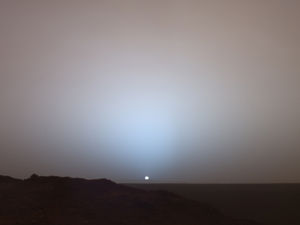Atmosphere
The Atmosphere of Mars is not breathable. The pressure is too low, and there is too little oxygen. And yet, it gives Mars something that makes it the most habitable of all planets in our solar system, except Earth of course. It provides valuable chemicals, and it forms a visible sky, mostly from dispersed dust. Also note that it protects from lower energy radiation particles, stopping 1.58% of the radiation from space, even tho it has only 0.6% of the Earth's air pressure.
Contents
Composition (gaseous parts)
Composition of Mars atmosphere by volume[1][2]
| Percentage | Gas |
| 96.0% | Carbon dioxide (CO2) |
| 1.93% | Argon (Ar) |
| 1.89% | Nitrogen (N) |
| 0.145% | Oxygen (O2) |
| 0.09% | Carbon monoxide (CO) |
| 0.03% | Water vapor (H2O) |
| trace | Neon (Ne), Krypton (Kr), Xenon (Xe), Ozone (O3), Methane (CH4), C2H2, C2H4, C2H6, CH3OH
CH3Cl, N2O, NO2, NH3, PH3, SO2, OCS, H2S, H2CO, HCl, NCN. |
Air Pressure
1-9 millibars (depending on altitude) or 600 Pa, average. This is 0.6% of Earth's air pressure at sea level.
Note that in the southern winter, approximately 30% of the atmosphere's carbon dioxide freezes out at the poles. (In the northern winter, about 12% freezes out.) Thus there is a strong seasonable component to the air pressure on Mars. The pressure ranges from about 1 bar to 0.7 bar over the course of the year (measured at the Viking lander sites). These values are lower at higher elevations.
If Mars had Earth's surface gravity, the atmosphere would be held more tightly, and compressed into a smaller volume. Since Mars' surface gravity is 38% of Earth's, the atmosphere is 'puffier' and extends farther into space.
The scale height of Mars (the relationship that says how quickly the atmosphere thins as you rise) is 10km. Thus every km you rise above the surface, the air pressure drops by about 10%. (This relationship works best near the ground, at very high altitudes, the atmosphere thins more slowly.)
Air Temperature
In the Earth's atmosphere, the atmosphere is warm near the ground, cools as it rises, then gets warmer near the stratosphere. (Due to the ozone layer stopping incoming UV light.) It then cools again until you reach near space, where the atmosphere is warmed by impacting particles.
On Mars it is similar except that there is no warming in the stratosphere since Mars lacks an ozone layer. Generally, the higher you go, the colder it gets, until you reach the homopause at about 120 km above the ground. The temperature of the air near the ground is about 240K while at 80 to 120 km the temperature is about 130K (degrees Kelvin). It warms slightly above this level as the atmosphere fades into space.
At times of large dust storms, the atmosphere is warmer due to the dust intercepting and reradiating heat.
During the day, the temperature of near ground air lags the temperature of the ground. Thus in the morning, the ground heats faster than the boundary layer. The air immediately above the ground gradually warms from the ground. In the evenings, the air is warmer than the cooling rocks. Near the ground, the air temperature typically ranges from 190K to 245K in the lower latitudes.
Color of the Sky
The color of the sky is usually reddish or salmon coloured due to the dust suspended in it. However, at times when the sky is very dust free, it can be blue, for the same reason that the Earth's sky is blue. (Red light is scattered more, so more blue light makes it down to the ground.)
References
The following text book is strongly recommended for detailed information on the atmosphere of Mars:
"The Atmosphere and Climate of Mars", Edited by: Robert M. Haberle, R. Todd Clancy, Francois Forget, Michael D. Smith, & Richard W. Zurek, Published by Cambridge Planetary Science, ISBN: 987-1-107-01618-7.
| This article is a stub. You can help Marspedia by expanding it. |







